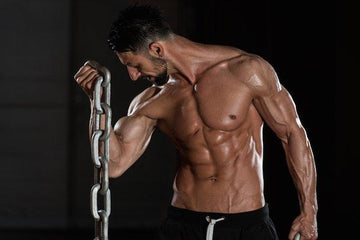

Muscle Growth- Not Growing? How to Break a Workout Plateau
Table of Contents
Not Growing? How to Break a Workout Plateau
By Joseph Palumbo IFBB Pro
We’ve all been there. Whether we’re trying to lose the last 10 pounds, or add just some more mass, then it comes…. that point in our progress where everything seems to come to a halt: A plateau occurs when you stall out on progress despite continuing to do all of the right things. A plateau is when our bodies become accustomed to the stresses we place upon it throughout weight training routine. It can also become accustomed to a certain caloric intake.
When you don’t adjust your caloric intake after your metabolism requires more calories to fuel your body for more muscle growth, you will plateau! When you train too often, or for too long, you begin to enter overtraining syndrome (OTS) which always leads to a plateau and frustrations. Think about this… the human body doesn’t care that you have some type of workout/exercise goal in mind. It doesn’t care that you want to build muscle, lose fat, get toned, or become stronger, or even improve performance. Your body’s sole purpose is to keep you alive and functioning as efficiently as possible. Your body is smart enough and capable enough to do whatever it takes to adapt to its environment.
Hitting a plateau is quite common and you shouldn’t flip out when it happens. Just know you must bust through it, and here is how…
For muscle to grow gains in strength, increase in performance, or improve in fitness, the human body must be forced to adapt to a pressure above and beyond what it has previously experienced; progression. It doesn’t need to be shocked or confused, it needs to be consistently challenged. There are different methods of training that will help you reach levels of intensity and bust out of your plateau. Here are some examples of my favorite workout techniques that will help you break through that training plateau and start putting results back into your routine.
SUPER SETS
The concept behind the super sets is to alternate exercises rapidly with almost no rest in between. A super set involves doing two different exercises in a row for different body parts. This works best when using opposite muscle groups. Here the advantage, while training the second muscle group, the first group is getting “rest” or “recovering”. This is a much faster workout with greater results. The objective is to do them back to back without rest or with as little rest as possible, the quicker with more intensity, the better.
DROP SETS
Drop sets are essentially a technique where you perform an exercise and then drop (reduce) the weight and continue for more reps until you reach failure. The reason why drop sets work is that in any given set you are only recruiting a certain amount of muscle fibers. By then stripping the weight down and going lighter for higher reps you recruit different muscle fibers (fast and slow twitch fibers).
There are significant benefits to mixing fast and slow twitch muscle fibers. Aerobic slow-twitch exercises increase stamina and oxygen supply allowing the body to burn energy (calories) for longer periods of time. Fast-twitch exercises burn considerably more energy in less time, and can lead to gains in muscle mass that may help trigger weight loss, lower blood pressure, and improve strength.
REST AND PAUSE
This will add some intensity to your workout. Rest-pause training breaks down one set into several mini-sets, with a short rest between each. Using the bench press to illustrate how a rest pause set would look, instead of cranking out five reps straight on the bench press, you will rack the bar after each rep to give your muscles 10-15 seconds to recover before doing the next rep. Using this rep scheme will allow you to handle much heavier loads than you normally use during regular rep schemes.
Which do you think is going to generate more muscle growth, a set of five reps straight in the bench press with 250 lbs., or five rest pause reps with 300 lbs. on the bench press? There is no doubt that the heavier load will result in more muscle growth. This is a favorite for power and strength athletes.
GIANT SETS
Giant sets are a great tool for saving you time in the gym while delivering major results. A giant set consists of 4 exercises with 10 reps all performed back to back with no rest, four different exercises working the same muscle group. For example, a chest giant set might consist of 10 reps on a flat bench press, 10 reps of dumbbell pec flies, 10 reps on a decline bench press and 10 reps of incline dumbbell presses. You can tailor the giant set to whatever muscle group you’d like. When performing a giant set, quickly move from exercise to exercise. Your rest period should not exceed 10 seconds. This increases the intensity of the workout and places greater demands on the muscle fibers, which spikes production of growth hormone and IGF-1. It’s fast, but it’s not easy.
FORCED REPS
It’s simple, but does require a partner who is willing to help you. Forced reps are repetitions in which your muscles are too fatigued to complete the rep, so a partner helps you complete it. The idea behind forced sets is similar to that of drop sets. Once you reach failure, have the spotter lift some of the weight for you. As you continue to fatigue, he lifts more and more of the weight. You can push out an extra 3 to 4 repetitions without any rest. By lightening the weight, you’re able to move past your initial muscle failure and eventually approach absolute muscle failure. Forced sets tear deep into muscle tissue and thus result in increased muscle growth – they are true shock to your system.
Weight training has an awesome metabolic effect, it is absolutely crucial for sustained fat loss. Muscles are like fat-burning incinerators, the more you add the more calories you will burn each day. Adding muscles is one of the best ways to lose fat and keep it off.
Word of Caution: the above styles of training techniques are extremely taxing and should only be used on occasion. Pick one technique and add it to your routine to fuel your mind and body. The following week choose another technique to terminate the next plateau.
Train Safe, Train smart.
Joseph Palumbo is an IFBB Professional Bodybuilder, Certified Trainer, Advance Sports Nutrition Specialist (ASNS), and a Certified Navy Seal Fitness Instructor. You may contact him at joeswat5@aol.com.

















